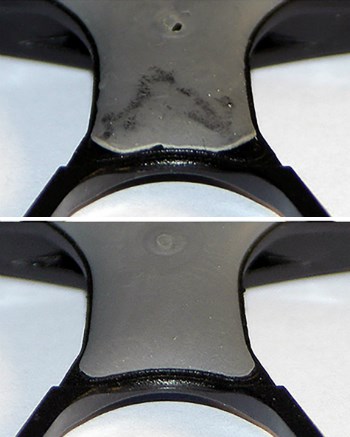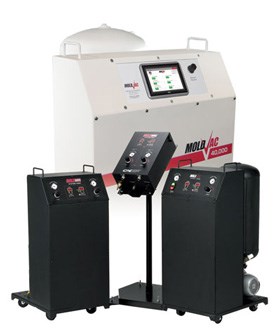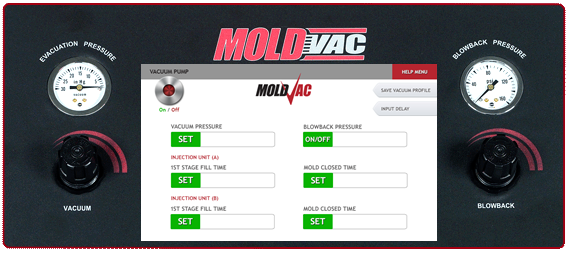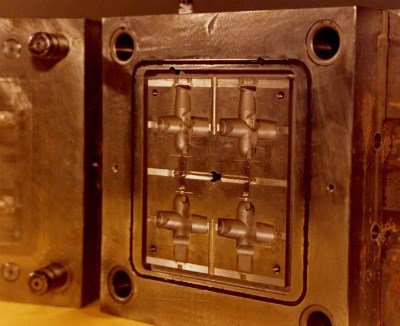How to Fix Outgassing Problems in Injection Molding
Sponsored ContentGas and air entrapment can cause a variety of problems in injection molding, including part burns, short shots, voids and blemishes, even clogged vents. Vacuum venting can solve all these problems, and increase output in the molding process.
Share

This thin layer wasn’t filling properly until vacuum venting was applied to the mold.
Proper venting is essential to molding a defect-free part. Without it, air and gas are trapped in the mold, which compress and heat as the cavity fills. Trapped gas is one of the most common causes of part burns, and can also lead to short shots and voids, blemishes and discernible knit lines that weaken the part. Moreover, trapped gas can cause residue buildup in vented pins, which then necessitates frequent production interruptions to clean the tool. It can even cause corrosion of the tool steel, thereby increasing tool maintenance costs.
Most injection molders know that, of course. But what do you do when conventional venting methods just don’t work?
The most common response to the problem is to slow down first-stage fill time to provide more time for the air or gas to dissipate. But that can be an expensive proposition. If you have to increase your first stage fill time from 1 second to 1.5 seconds, what is the cost of that additional cycle time?
There is a better way. Vacuum venting can alleviate all these problems by instantaneously evacuating air and gas from the mold cavity as it is filled. Mold-Vac is a company that makes such a system. Moreover, its proprietary technology also includes a “blowback” circuit that purges vented pins to reduce maintenance on the mold.
This video shows what can happen with a poorly vented mold. As the cavity is filled, air and gas are trapped, which is simulated by steam above. Once the vacuum is activated, the trapped gases are instantaneously evacuated from the mold.
How it Works

Mold-Vac units come in four sizes and can handle almost any size mold or application.
The self-contained Mold-Vac unit includes a vacuum reservoir, separate circuits for the vacuum and blowback functions, and a microprocessor control that triggers both, adjustable to 1/10th of a second. As the mold closes, the vacuum reservoir is discharged, which creates an instant vacuum in the mold, releasing any air or gas as the cavity is filled. As the video above shows, the evacuation of mold gasses is virtually instantaneous. Indeed, Mold-Vac’s largest unit can move 1,665 cubic inches of air per second.
The patented blowback circuit has two phases. To assist with part ejection, the first phase provides a burst of air just prior to the mold open. Opening the mold under vacuum can cause part distortion, and the blowback feature eliminates that problem. The second phase activates upon mold open to purge vented pins. This helps keep the vent pins cleaner longer, which can substantially reduce maintenance requirements and tool steel degradation caused by residue buildup.

The control enables precise setting of vacuum and blowback pressures and trigger points for each, controllable to a 10th of a second.
Mold-Vac venting units come in four sizes with vacuum capacities respectively of 18, 36, 900 and 1,665 cubic inches per second, so they work from small to very large molds. The vacuum level for each is adjustable between 0 to 24" Hg. Smaller units use compressed air; larger units include a servo-controlled vacuum pump. The choice of which works best with any specific application depends on the part volume, first-stage fill time and mold design.
What Parts and Materials Require Vacuum Venting?

Before and after vacuum venting.
Mold-Vac has been used on a wide range of thermoplastic and thermoset materials including ABS, acetyl, nylon, PEI and PEEK, PPO, PP, phenolics and more. But, the need for vacuum venting isn’t nearly as much about the material as it is about the requirement to consistently produce high-quality parts when outgassing or air entrapment is a problem.
Where vacuum venting shines most is when part quality requirements are stringent and molders don’t want to sacrifice processing speed to meet those standards. High-return applications include:
- Engineered resins such as glass-filled nylons, glass-filled PBT and acetals
- High-speed injection of thin-walled parts
- Optical parts such automotive lighting, light pipes and lenses
- Medical applications where part clarity is important and “air bubbles” are common.
Does Vacuum Venting Require Tooling Modifications?

This mold shows the O-ring modification that is used when venting at the parting line.
Almost any mold can be fitted with Mold-Vac, but if the problem is gas or air entrapment the tool will require minor modifications to properly configure the vacuum venting channel.
With a parting line installation, an O-ring and chimney are cut around the cavities. The O-ring seals the closed mold to help maintain the vacuum, and the chimney creates the passage for air or gas to exit the cavity.
On long, thin wall sections with an insert, it’s often best to vent as close to the bottom of the insert as possible. In this case, it’s recommended that insert walls in contact with the mold base be coated with grease or RTV silicone to prevent vacuum leakage.

Another method is to vent through the ejector pins of a mold. To maintain maximum vacuum, it may be necessary to seal the ejector pins with a heat resistant Viton seal.
Mold-Vac works with its customers to develop the best venting strategy for each application. For shops capable of building and modifying tooling in-house, Mold-Vac analyzes the existing mold design and then provides a full set of drawings or a CAD file that describes the necessary modifications. For processors sending their molds out for this kind of work, the cost typically runs from $500 to $2,000, with a very complicated tool capping out around $3,000.
Will Mold-Vac improve every injection molding process? Not necessarily, especially if a process problem is not related to air or gas entrapment. But where outgassing is a problem, vacuum venting is an extremely effective—and cost-effective—way to consistently deliver high-quality parts without sacrificing cycle times and with fewer process interruptions for mold maintenance. That’s technology that is very easy to justify.
Visit Mold-Vac for more information or call them at 630-425-6100.